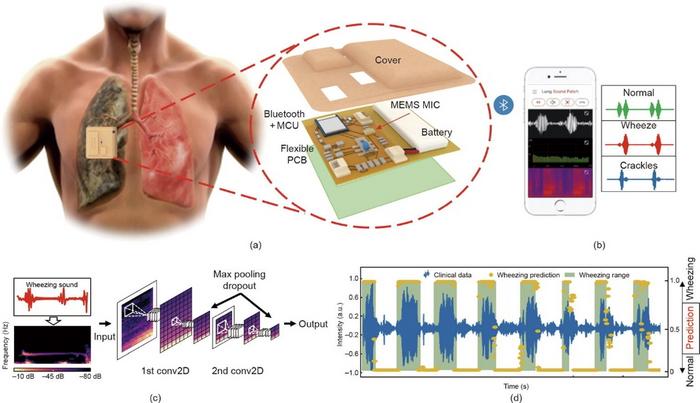A revolutionary advancement in the field of respiratory diagnostics has emerged with the introduction of a wearable stethoscope designed for continuous and accurate lung sound monitoring. This innovative device, developed by a team of researchers, addresses the inherent limitations associated with traditional stethoscopes, which heavily rely on the expertise of the attending clinician and can easily be disrupted by external noises. The wearable stethoscope represents a remarkable leap forward in medical technology, particularly in the realm of respiratory disease management, where real-time monitoring is crucial.
The traditional stethoscope has been a staple in medical practice since its inception in 1816, serving as a primary tool for diagnosing various conditions through auscultation. However, despite its long-standing utility, the conventional device has its drawbacks, particularly when it comes to accuracy and precision. These limitations stem from a combination of factors such as the user’s expertise and the impact of ambient noise during examinations. While digital stethoscopes have made great strides in improving these areas, they fall short when it comes to convenience and usability. This is where the era of wearable technology initiates a profound transformation, offering more reliable and efficient solutions.
To validate the efficacy of the LSMP, comprehensive testing was conducted involving a range of subjects, from healthy individuals to patients with different respiratory conditions, including pediatric asthma and chronic obstructive pulmonary disease (COPD). During these tests, the LSMP demonstrated its ability to accurately differentiate between normal and abnormal breathing patterns, showcasing its potential in clinical settings. Notably, the device excelled in extracting vital metrics such as heart rate and respiratory rate from bioacoustic signals, establishing itself as a superior alternative to existing electronic stethoscopes.
In specific scenarios, such as analyses involving pediatric asthma patients, the LSMP effectively identified distinct wheezing signatures in real-time, facilitating a deeper understanding of abnormal breathing patterns. Conversely, when applied to elderly patients suffering from COPD, the LSMP faced challenges posed by noisy environments. Nevertheless, it managed to successfully classify normal and abnormal breathing sounds through advanced analytical techniques, including discrete and continuous wavelet transforms. These capabilities speak volumes about the LSMP’s robustness in diverse conditions, setting a new standard for respiratory monitoring.
An integral aspect of the LSMP’s functionality is its incorporation of an artificial intelligence-based algorithm, crafted from a two-dimensional convolutional neural network (CNN). This sophisticated algorithm allows for meticulous classification of breathing sounds and precise counting of wheezing events. To ensure high performance, the researchers trained this model utilizing a wealth of augmented lung-sound data, resulting in a remarkable match rate of approximately 80.5% during long-term clinical trials with COPD patients. This statistic underscores the algorithm’s accuracy and reliability in monitoring crucial respiratory indicators over extended periods.
Looking ahead, the researchers are optimistic about the potential applications of this wearable stethoscope in clinical practice. Future developments are expected to include the integration of active noise cancellation technology aimed at enhancing the device’s performance in daily activities. By facilitating consistent 24-hour monitoring, this wearable device has the potential to generate comprehensive datasets that can significantly inform medical decision-making processes. Such data can help clarify the intricate relationship between lung sounds, environmental changes, and treatment responses, paving the way for more personalized healthcare strategies.
Moreover, the impact of this groundbreaking wearable stethoscope may extend far beyond mere diagnostics; it could fundamentally alter how respiratory diseases are managed and treated. By providing healthcare professionals with a constant stream of data, they can proactively respond to changes in a patient’s condition, leading to timely interventions and improved patient outcomes. This level of real-time monitoring could revolutionize healthcare, particularly in the management of chronic conditions like asthma and COPD, where early detection of exacerbations is critical.
In a world increasingly reliant on technological innovations, the development of the LSMP exemplifies the exciting future of medical diagnostics. As the field of wearable technology continues to evolve, we can expect similar breakthroughs across various domains of health and medicine. Such advancements will not only enhance patient care but also contribute to a paradigm shift in how clinicians interact with and understand their patients’ conditions.
The research paper titled “A Wearable Stethoscope for Accurate Real-Time Lung Sound Monitoring and Automatic Wheezing Detection Based on an AI Algorithm” encapsulates these findings and elaborates on the various aspects of the study, establishing a comprehensive foundation for future investigations in this field. The collaborative efforts of the research team, including Kyoung-Ryul Lee, Taewi Kim, and several others, highlight the interdisciplinary nature of modern medical research and the importance of innovative thinking in overcoming the challenges posed by existing diagnostic tools.
As we stand on the precipice of a new era in medical technology, the potential of wearable devices in healthcare is just beginning to be realized. This wearable stethoscope represents not merely an advancement in diagnostic capabilities but symbolizes a broader shift towards more patient-centric care models that prioritize continuous monitoring and proactive healthcare strategies. The integration of technology into everyday healthcare practices promises to reshape our approach to medicine and ultimately lead to better health outcomes for individuals worldwide.
Subject of Research: Wearable stethoscope technology for lung sound monitoring
Article Title: A Wearable Stethoscope for Accurate Real-Time Lung Sound Monitoring and Automatic Wheezing Detection Based on an AI Algorithm
News Publication Date: 17-Jan-2025
Web References: DOI Link
References: Kyoung-Ryul Lee et al., Engineering, 2025
Image Credits: Kyoung-Ryul Lee et al.
Keywords: Wearable stethoscopes, lung sound monitoring, MEMS microphones, respiratory diagnostics, AI in healthcare
Tags: accurate auscultation methodsadvancements in stethoscope designambient noise impact on diagnosticscontinuous respiratory diagnosticsdigital stethoscope improvementsevolution of medical monitoring toolsinnovative medical technologylimitations of traditional stethoscopesreal-time lung sound analysisrespiratory disease management solutionsuser-friendly wearable health deviceswearable lung sound monitoring device





